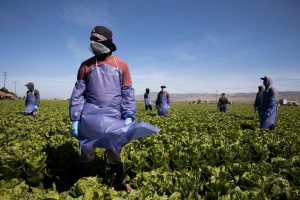MAY 29, 2020

North America Immigrant Agricultural Workers Critical To U.S. Food Security Amid COVID-19 Outbreak, – Photographer: Brent Stirton/Getty Images
All of the roughly 200 employees on a produce farm in Tennessee tested positive for Covid-19 this month. In New Jersey, more than 50 workers had the virus at a farm in Gloucester County, adding to nearly 60 who fell ill in neighboring Salem County. Almost 170 were reported to get the disease at a tomato and strawberry greenhouse complex in Oneida, New York.
The outbreaks underscore the latest coronavirus threat to America’s food supply: Farm workers are getting sick and spreading the illness just as the U.S. heads into the peak of the summer produce season. In all likelihood, the cases will keep climbing as more than half a million seasonal employees crowd onto buses to move among farms across the country and get housed together in cramped bunkhouse-style dormitories.
The early outbreaks are already starting to draw comparisons to the infections that plunged the U.S. meat industry into crisis over the past few months. Analysts and experts are warning that thousands of farm workers are vulnerable to contracting the disease.
Aside from the most immediate concern — the grave danger that farmhands face — the outbreaks could also create labor shortages at the worst possible time. Produce crops such as berries have a short life span, with only a couple of weeks during which they can be harvested. If a farm doesn’t have enough workers to collect crops in that window, they’re done for the season and the fruit will rot. A spike in virus cases among workers may mean shortages of some fruits and vegetables at the grocery store, along with higher prices.
“We’re watching very, very nervously — the agricultural harvest season is only starting now,” said Michael Dale, executive director of the Northwest Workers’ Justice Project in Portland, Oregon, and a lawyer who has represented farm workers for 40 years. “I don’t think we’re ready. I don’t think we’re prepared.”
Unlike grain crops that rely on machinery, America’s fruits and vegetables are mostly picked and packed by hand, in long shifts out in the open — a typically undesirable job in major economies. So the position typically goes to immigrants, who make up about three quarters of U.S. farm workers.
A workforce of seasonal migrants travels across the nation, following harvest patterns. Most come from Mexico and Latin America through key entry points like southern California, and go further by bus, often for hours, sometimes for days.
There are as many as 2.7 million hired farm workers in the U.S., including migrant, seasonal, year-round and guest-program workers, according to the Migrant Clinicians Network. While many migrants have their permanent residence in the U.S., moving from location to location during the warmer months, others enter through the federal H2A visa program. Still, roughly half of hired crop farmworkers lack legal immigration status, according to the U.S. Department of Agriculture.
These are some of the most vulnerable populations in the U.S., subjected to tough working conditions for little pay and meager benefits. Most don’t have access to adequate health care. Many don’t speak English.
Without them, it would be nearly impossible to keep America’s produce aisles filled. And yet, there’s no one collecting national numbers on how many are falling sick.
“There is woefully inadequate surveillance of what’s happening with Covid-19 and farm workers,” said Erik Nicholson, a national vice president for the United Farm Workers. “There is no central reporting, which is crazy because these are essential businesses.”
On the Tennessee farm where workers caught the virus, only a very few showed any symptoms. After an initial worker tested positive for Covid-19, all employees at Henderson Farms in Evensville were given tests out of an “abundance of caution,” revealing the infection had spread among all of them. The workers are now all in isolation at the farm, where they live and work.
“We take our responsibility to protect the essential workers feeding the nation through the pandemic seriously,” Henderson Farms Co. said in a statement. “In addition to continuing our policy of providing free healthcare, we have implemented additional measures to support workers directly impacted by Covid-19, including those in isolation as per the latest public health guidelines. We are working closely with public health officials in Rhea County, Tennessee, to ensure we can continue to deliver our high standard of care as we support our workers and our community through these unprecedented times.”
Critical Months
May and June mark the start of a critical few months when migrant workers head to fields in North America and Europe to plant and gather crops. Travel restrictions amid the pandemic are already creating a labor squeeze. In Russia, the government is calling on convicts and students to fill in the labor gap on berry and vegetable farms. In the U.K., Prince Charles took to Twitter to encourage residents to #PickForBritain. Farmers in western Europe usually rely on seasonal workers from eastern Europe or northern Africa.
In Canada, migrant workers often come from Jamaica, Guatemala and Mexico. They’re typically housed on farms, with two or four people sharing a room, depending on if there are bunk-beds, said Colin Chapdelaine, president of BC Hot House, a greenhouse farming company that grow tomatoes, peppers and cucumbers in Surrey, British Columbia.
All the houses are audited and approved by regulators with guidelines for how much kitchen and bathroom space to provide, but “Covid has kind of turned that on its head,” he said.
“It’s a precarious situation if something happens and it flows through a greenhouse and you can’t pick your crop,” Chapdelaine said. “We’re taking huge precautions to make sure everyone comes in suited and masked up. You have to do all the right things and still hope for the best.”
In the U.S., migrant farm workers primarily come from Mexico and Latin America.
President Donald Trump has sought to maintain the flow of foreign workers to U.S. farms during the pandemic, waiving interview requirements for some guest workers when consular offices shut down and exempting them from a temporary immigration ban. But so far, the administration hasn’t created rules to protect the workers. Democratic Representative Jimmy Panetta of California and 71 other members of Congress urged in a letter last week that the next coronavirus relief package include funding dedicated to combating spread of the virus among farm workers.
Even before infections started to creep up, there weren’t enough workers, causing harvest issues in parts of the U.S. Some prices started to move up. A 2-pound package of strawberries is fetching about 17% more than it was last year, and a pint of cherry tomatoes is 52% higher, USDA data as of May 22 show.
So far, though, the price impact has been limited. As restaurants shuttered during virus lockdowns, many farmers lost a key source of produce demand, creating some supply gluts.
Now, stay-at-home restrictions are easing in all 50 states, and some restaurants are opening back up. Meanwhile, labor shortages could get worse as illness among farm workers deepens.
“The cost will go up, and there will be a little bit less available,” said Kevin Kenny, chief operating officer of Decernis, an expert in global food safety and supply chains. “You really will see some supply issues coming.”
Perishable crops that require more hands on labor to pick are the most at-risk of disruptions, including olives and oranges, Kenny said.
In Florida, oranges are “literally dying on the vines” as not enough migrants can get into the country to pick the crops and things like processed juice will probably cost more in the coming months, he said.
When the virus spread among America’s meat workers, plants were forced to shutter as infections rates topped 50% in some facilities. Prices surged, with wholesale beef and pork more than doubling, and grocers including Kroger Co. and Costco Wholesale Corp. rationed customer purchases. Even Wendy’s Co. dropped burgers from some menus. After an executive order from Trump, plants have reopened, but worker absenteeism is restraining output. Hog and cattle slaughter rates are still down more than 10% from last year.
The produce industry could see similar problems because workers face some of the same issues. They sometimes work shoulder to shoulder. They are transported to and from job sites in crowded buses or vans. They often come from low-income families and can’t afford to call in sick or are afraid of losing their jobs, so they end up showing up to work even if they have symptoms.
“A lot of people are concerned that the summer for farm workers will be like the spring for meat packers,” said David Seligman, director of Towards Justice, a nonprofit law firm and advocacy organization based in Denver.
There’s “a lot of worker fear because of the asymmetry of power in this industry,” Seligman said. “We’re hearing anecdotal reports. Gathering information about farm workers is very hard because of how scared and how isolated they are.”
There are some key differences between the two industries. For one, farm workers spend most of their time outside, and some research has shown that the virus is less likely to be spread outdoors. Meanwhile, meat workers are piled into cold, damp factories where infectious diseases are particularly hard to control.
In other ways, farm workers are more exposed. Living conditions can be even more cramped, with close-together bunks and communal cooking and bathroom facilities that make physical distancing extremely difficult.
Plus, the workers move around so much, meaning increased chances of exposure for themselves and more chances that sick individuals can spread the illness to other communities.
In Oregon, a farm worker often may move a half dozen times during the summer, working for new growers and housed in new labor camps as they shift from harvesting cherries to strawberries to blueberries to pears, said Dale of the Northwest Workers’ Justice Project.
Nely Rodriguez is a former farm worker who is now an organizer with the Coalition of Immokalee Workers in Immokalee, Florida, a major tomato growing area. She said that some farms are taking steps to protect migrants, such as having buses make more trips so workers won’t be as cramped and requiring them to wear masks, as well as providing more hand-washing stations and sanitizer.
Lisa Lochridge, a spokeswoman for the Florida Fruit and Vegetable Association, also pointed to increased measures to protect workers and said some employers even set aside separate housing to be used for a quarantine area if necessary. Cory Lunde, of the Western Growers Association, said farm owners are staggering start times, disinfecting buses and increasing distances between workers, both in the field and in packing facilities and offices.
But protection measures can be spotty, said Rodriguez of the Coalition of Immokalee Workers. There aren’t yet any farm specific Covid-19 safety protocols from the federal government.
Developing Guidance
The USDA is “diligently working” with the the U.S. Centers for Disease Control and Prevention and the Occupational Safety and Health Administration “to develop guidance that will assist farmworkers and employers during this time,” the agency said in an emailed statement.
“Additionally, considering the seasonal and migratory nature of the workforce, we are working to identify housing resources that may be available to help control any spread of Covid-19,” the USDA said.
Harvests take place at different times across the country, depending on the weather and the crop. That means when gathering finishes in an early state like Florida, workers will travel into areas such as Georgia, North Carolina, Indiana and New Jersey, said Rodriguez of the Coalition of Immokalee Workers. They’ll often make the journey on old school buses rented by employers, sitting for 7 or 8 hours at a time with 45 people crammed in.
“If there is a bunch of farm workers here that are sick, they can essentially spread this virus to other rural communities,” Rodriguez said.
Many farm workers come from indigenous communities in southern Mexico and don’t speak English or Spanish as their first language, so they don’t have adequate information on the pandemic in a language they can understand, said Bruce Goldstein, president of Farmworker Justice, a national advocacy group.
They typically don’t have easy access to coronavirus tests, and many are undocumented so they are concerned about reporting illnesses, he said.
“They’re marginalized in Mexico. They’re similarly marginalized here,” Goldstein said. “People like that are incredibly vulnerable to Covid-19.”
Courtesy/Source: Bloomberg










































































































